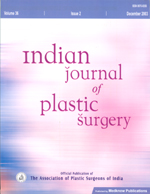
|
Indian Journal of Plastic Surgery
Medknow Publications on behalf of Indian Journal of Plastic Surgery
ISSN: 0970-0358
EISSN: 0970-0358
Vol. 40, No. 1, 2007, pp. 61-67
|
 Bioline Code: pl07016
Bioline Code: pl07016
Full paper language: English
Document type: Research Article
Document available free of charge
|
|
|
Indian Journal of Plastic Surgery, Vol. 40, No. 1, 2007, pp. 61-67
| en |
Case Report - Reconstruction of lower end of radius using vascularized upper end of fibula
Koul, Ashok Raj; Patil, Rahul K; Philip, Vinoth Kumar & Kale, Subhash M
Abstract
Background: Giant cell tumor is a fairly common locally invasive tumor in young adults. The lower end of the radius is the second commonest site for this tumor. The most common treatment for this tumor is curettage with or without bone grafting but it carries a significant rate of recurrence. Excision is the treatment of choice, especially for cases in which the cortex has been breached. After excision of the distal end of the radius, different procedures have been described to reconstruct the defect of distal radius. These include partial arthrodesis and hemiarthroplasty using the upper end of the fibula. The upper end of the fibula has a morphological resemblance to the lower end of the radius and has been used to replace the latter. Traditionally it was used as a 'free' (non-vascularized) graft. More recently the upper end of the fibula has been transferred as a vascularized transfer for the same purpose. Though vascularized transfer should be expected to be more physiological, its superiority over the technically simpler non-vascularized transfer has not been conclusively proven.
Materials and Methods: Two patients are presented who had giant cell tumor of distal radius. They underwent wide local excision and reconstruction with free vascularized upper end of the fibula.
Result: Follow-up period was two and a half years and 12 months respectively. Both patients have returned to routine work. One patient has excellent functional result and the other has a good result.
Conclusion: Vascularized upper end of fibula transfer is a reliable method of reconstruction for loss of the distal end of the radius that restores local anatomy and physiology.
Keywords
Distal radius, free vascularized fibula, giant cell tumor
|
| |
© Copyright 2007 Indian Journal of Plastic Surgery.
Alternative site location: http://www.ijps.org/
|
|
